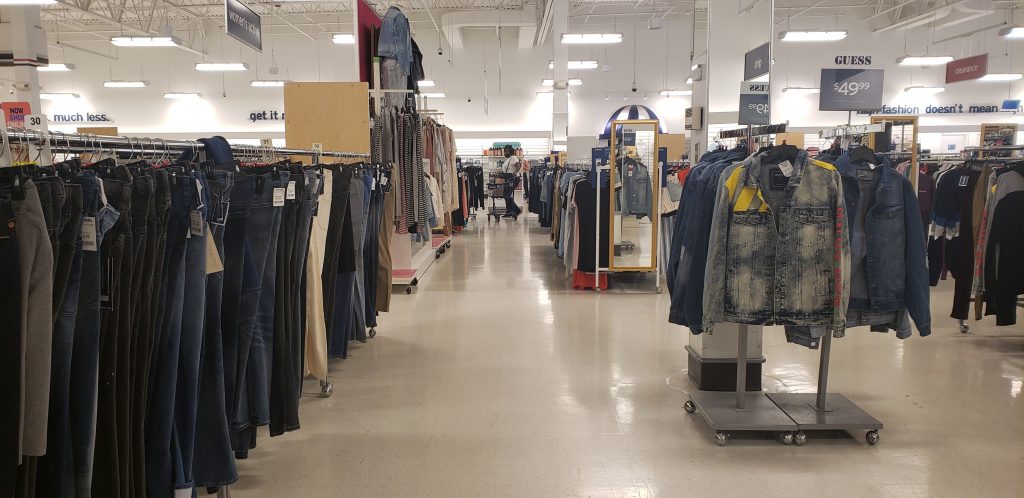2020 Took No Prisoners; Didn’t Even Spare Clearance Sales
I made my quarterly trip to Marshalls yesterday. Marshalls is notably one of the few big box stores actually in the city limits of Detroit. Well, barely in the city limits. You can throw a rock and hit Ferndale from the parking lot. It was one of a few errands to run on a Sunday morning, the first of which was stopping by an abandoned Walgreen’s on Grand River, where the company had mustered a skeleton crew of nonetheless uniformed staff to provide COVID testing (the young lady is going on a road trip for work and figured it would be prudent). Truly the strangest timeline, I thought, watching a white-coated woman with a hijab and a clipboard emerge from a pair of plywood-covered glass doors. But anyway. COVID and the retail apocalypse.
IT’S THE DEALS
Like everyone else, I go to Marshalls for the deals. To be clear, I go for a very limited number of deals. I go for high-end face care products discounted by, you know, orders of magnitude. $5 for a 3.4oz. jar of LUMENE LÄHDE night cream. Or $3 for a product called BioMilk that smells delicious. Tony Moly Argan Oil Face Wash for $2? Get out! Or another Korean product that advertised its skill in “removing sebum within deep pore,” which I sometimes mutter to myself while washing my face because I enjoy the phrase enormously. I also go for jeans. I wear out the average pair of jeans after several dozen wears. They always develop a wear spot, and then a hole, and then a proper tear. Always in the crotch. This is a product of preferring a slimmer fit, having a big butt, and having muscular thighs and calves, and, probably, riding a bike.
But anyway, much as I used to revel in being able to find deals on US-made denim, especially particularly high-quality denim, none of them ever particularly wore too well. None were ever covered under some sort of warranty. I wore through a pair of Imogene + Willie’s jeans that I bought at erstwhile Willy’s Detroit. Willy’s was the predecessor of the Filson store, spiritually and spatially. I ogled at the jeans– and balked at the price tags- until the store went out of business and they were sold for 60% off. I bought two pairs. One wore out within six months. (And we see what happened to that company). So, this is a lengthy tangent to illustrate that in many cases, there is not a perfect solution. My solution is to go to Marshalls a couple of times a year and spend $30 on two pair of jeans that vaguely fit. Compare this to driving another 20 minutes farther north to exurban Nordstrom Rack and spending five to ten times more on a pair of “discounted” jeans– that will, indeed, not wear any better.
MARSHALLS, A TJX COMPANY
Off-price retailer Marshalls– no relation to the legendary Marshall Fields- was bought by the parent company of TJ Maxx in 1995. The company’s founder was kind of an interesting dude. Unlike the Burlington Brands of my youth, where they actually cut out the labels of clothing to prevent shoppers from seeing what they were buying, Marshalls and TJ Maxx sell normal brands of overstock as well as their own cheap brands– much like Nordstrom Rack. It’s a mix of normal-priced stuff and some steals on clearance. The store, closed in Michigan for a bit during the dark depths of the spring lockdowns, reopened as normal in the spring. But at some point over the past few months, the stock was depleted by about a third or more. No, it wasn’t one of those COVID-related supply chain disruptions. Rather, the racks themselves were moved farther apart– whereas you used to have maybe four or five feet between the center bars of clothing racks, now that distance is more like 10 or 12 feet. Mention of this was notably absent from CEO Ernie Herman’s PSA to investors earlier this year that basically said, “we’ll get through this.” The Wall Street Journal gushed. TJX Will Endure!
BUT WILL IT? WILL IT HURT SALES?
Ok, let’s look at this. Less stock means a smaller distribution of product data points, if you will, which is effectively where clearance sales come from– selling excess volume. If there is no excess volume, there can be no clearance sales. The argument is to distance customers by reducing store capacity. But certainly the draw has to be reduced. I’m probably not spending $15.99 on a shirt that they used to sell for $7.99. I’m also probably not spending $24.99 on clearance jeans, but I’ll definitely spend $12.99– if I can find it. The question is whether a decrease in the distribution of data points as far as products offered at fire sale discount prices will actually lead to a decrease in sales. I’d suggest that it will– as a matter of volume, if not as a matter of the consumer’s preference for bundling discounted purchases with normal priced purchases. In other words– come for the $2 Tony Moly, stay for the less heavily discounted packaged Italian cookies, or shorea housewares branded as “reclaimed wood” and emblazoned in acrylic paint with platitudes like Live, Laugh, Love.
GAUGING PROFITABILITY IN THE AGE OF THE RONA
Retail often gauges profitability by profit per square foot. Interestingly, the top performers in the US retail space are not all luxury– one is a gas station/convenience store chain. If they are competing with Tiffany’s and Apple, they have to be doing something better than the competition. (I suspect our Chaldean-owned liquor store around the corner could give them a run for their money, too). Less stuff for sales definitely translates to less clearance. In our case, there were no clearance items– in any section. Some sections were even entirely cleaned out. And less stuff for sale– given the same relatively low quality, and without more of a reason to come in- almost certainly translates to less in sales.
In the end, we “only” spent $75, including four personal care and beauty products, two dog toys, two pairs of jeans, and probably the only soy candle that wasn’t pumpkin spice flavored. So, maybe I disproved the point I was trying to make with my question. But generally, the appeal is lost when I can’t see those little red tags proclaiming a wild surplus of savings. I guess we will see how it shakes out.
Editorial note: “You go to Marshalls more than twice a year,” my girlfriend said, frowning as she read what I had previously characterized as a ‘semiannual’ trip. “You love that shit.” I confess.


